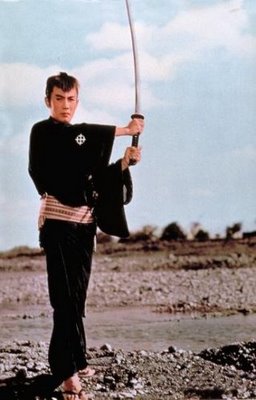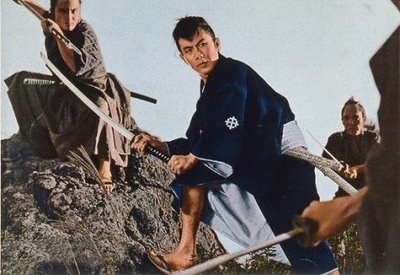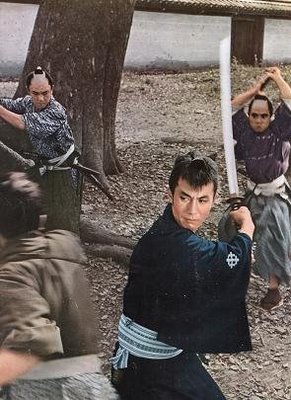Son of the Black Mass Triple-Header
It’s time for the long-awaited review of the second through fourth movies in the mid/late 1960’s series, THE SON OF THE BLACK MASS (or, as they’re known in the US, THE SLEEPY EYES OF DEATH) staring ill-fated Raizo Ichikawa as the nihilistic ronin Kyoshiro Nemuri, who wanders through late Tokugawa Japan (circa 1825 – 1835) cutting numerous bitches with his mystic Full Moon Cut.
I reviewed the first movie (THE CHINESE JADE: 1963) in the series way back on 10-26, in my never-to-be-forgotten second post for Cheese Magnet. For those of you who have forgotten what I said, a quick recapitulation: JADE is a rather straightforward chambara, mixed equal portions of action and melodrama, with a complicated plot concerning a jade statuette which two powerful men are after because it has hidden in its base evidence that will condemn one of them to probable execution while exonerating the other. Both, unfortunately, are scumbags. Both want Nemuri on their side in the burgeoning conflict and try to hire him to find the jade. One of them sends a woman to draw Nemuri into the bloody plot. She does, though not exactly as expected, as the plot twists, heads roll and numerous rather incompetent ninja are dispatched with stoic aplomb by Nemuri. There are also hints as to possible supernatural elements in the character’s background, as he survives a shooting with no ill effects as well as certain death traps with little or no explanation, much like Clint Eastwood’s character in HIGH PLAINS DRIFTER. I am looking forward to seeing more of the series and watching the character unfold.
I have now viewed the first four movies in the series, and his character does indeed unfold, and I can pat myself on the back for my remarkable prescience, for I am now pretty certain that what we have on our hands is indeed a High Plains Drifter situation. We’ll look at the films one at time.
Son the Black Mass #2: Sword of Adventure (original title: Shobu) 1964
File Under: Martial arts: Japan: historical (1825-1835): chambara; fantasy?
In this installment we learn the first hints of Nemuri’s origin when a female character really gets his ire up when she speculates that he may be result of a “mixed marriage,” that is, between a European father and a Japanese mother. Nemuri also doesn’t have a lot of nice things to say about Christians in general, yet, when push comes to shove he’s willing to help a Christian priest simply because he recognizes the sorrow on Nemuri’s face. Along with his anger in general towards Christianity, another of the series’ common tropes appears for the first time, the casting of Shogun’s children as antagonists. This theme continues throughout the series. Fortunately, the Shogun had a lot of children.
The acting and cinematography continue to impress. The quality of Nemuri’s opposition is racheted up as the antagonist recruits a dirty half dozen or so samurai, ninja and general ne’er do wells to go up against Nemuri. only one of them survives, a consumptive samurai seeking death by Nemuri’s sword. It would be interesting if he turns up in a future installment.
I’m going to forego any kind of detailed plot recapitulation to concentrate on what we learn about the character as the movies progress.
I’ve already mentioned that we get a hint about his origins. We certainly also learn about his antipathy toward Christianity. In the first entry, Nemuri is apparently shot at close range, but pops up unharmed to do in the shooter. In this episode, he’s poisoned, but instead of being fatally injured, is only mildly inconvenienced. Perhaps, it turns out, he was even faking that effect, again playing possum to get the drop on some sword fodder.
Another point that I haven’t touched on so far is his appearance. In the first episode, his hair is red, or anyway dark with a reddish tint. It seems somewhat redder this time around. In any case, red hair is associated in Japanese myth with demons or troublesomely ferocious spirits. In addition, his eyebrows are distinctly Spock-like. They sweep upwards at the end, heading for his hair line. His haircut in general is unusual if not unique in my experience in viewing chambara films. He has the usual top knot, but also an odd cut to his bangs which give him a pronounced widow’s peak. All in all his appearance is, shall we say, a bit devilish?
A final point I haven’t discussed in detail is his distinct sword move, the Full Moon Cut. He uses this in duels, not in prolonged sword battles but when he faces a single opponent in face to face combat. He starts with his sword point almost touching the ground. He moves the sword upward in a slow, counter-clockwise motion, basically using his wrists to circumscribe a circle upon the air. He always tells his opponents that they will be dead before the sword completes the circle. Inevitably, they rush in at an inopportune time and are skewered. Does the motion of the sword somehow mesmerize his opponents and lure them to their doom by causing them to attack while in a weak position? Or is he casting a spell of some sort?
Keep all this in mind while we move on to the other movies in the series.
Better than THE CHINESE JADE, this movie rates a 9.
Son of the Black Mass #3: Full Circle Killing (Engetsugin) 1964
File Under: Martial arts: Japan: historical (1825-1835): chambara; fantasy
This episode has a tangled, complicated plot, replete with evil Shogunate spawn and social justice themes. There is no mention of Nemuri’s origins.
This time around Nemuri defeats a master of Iai (quick-draw sword fighting from a seated position) showing preternatural speed. He is always utterly confident that he’ll survive any battle or trap. Sure, this is a somewhat common take in chambara movies, but it really stands out in this series. Also, has Nemuri ever been even wounded in battle so far? I don’t think so.
Along the twisted path of FULL CIRCLE KILLING he comes across Konami, the beautiful daughter of a rich rice merchant, who’s betrothed to the son of the shogun. This particular Shogun spawn is way down on the list of succession. But the kid — or rather his mother — has a plan, and as the film moves along the kid moves right on up the list. Quickly. Meanwhile, Nemuri and Konami meet a couple of times. Generally, sparks fly, but that doesn’t prevent them from exchanging significant glances. Konami spends most of her time protecting her virtue from the clutching hands of her hubby to be, but at one point she and Nemuri meet up (and that’s another part of the character’s mystery; he’s always showing up in the most unexpected places at the most inopportune times) in her bedroom late one night, and stuff happens. It seems that he rapes her. But when they meet again later and she has harsh words for him he just looks at her and says, you have no reason to be angry with me, or words to that effect, and she agrees. We as the audience never learn exactly what happened between them. And where have we seen this exact sequence played out before? That’s right. When the Drifter drags the hotel owner’s wife off to his room in HIGH PLAINS DRIFTER.
The climax of FULL CIRCLE takes place at night where he battles, oh, thirty or forty samurai minions of the Shogun’s spawn. He has the upper hand, so the spawn’s men set fire to the bridge, which burns merrily and then collapses. Shogun’s spawn rejoices, prematurely, as Nemuri suddenly appears against a background of dancing, roaring flames. Where have we seen that before? Did you say HIGH PLAINS DRIFTER? If so, you’d be correct. Nemuri coaxes his foe into a mano-a-mano face-off, and when the feckless Shogun wannabee charges him in the middle of his Full Moon move, Nemuri steps aside, cuts him, and he stumbles into the still raging inferno where the logs collapse on him and he’s consumed by, dare I say?, the fires of Hell.
In the final sequence, after some Shogun troops show up to wipe out the riff-raff who are still alive, a hairpin suddenly appears on the ground next to where the villain had fallen into the fire. It’s Konami’s hairpin. Earlier, she’d committed suicide after ratting out her intended hubby by disclosing his nefarious scheme to assassinate all those higher on the succession list. I didn’t see anyone drop it there. If no one did, this is clearly the first unambiguous supernatural event in the series, and we can firmly place this movie in the fantasy camp.
Superior effort, rating a 10.
Son of the Black Mass 4: Sword of Seduction (Joyoken) 1964
File under: Martial arts: Japan: historical (1825-1835): chambara; fantasy
These movies are coming faster and faster, almost as if they were television miniseries, which reminds me to reflect upon something that I briefly touched upon in my first review. The character originated a series of novels written by notable Japanese author Renzaburo Shibata in the 1950’s. Shibata was a best selling novelist in Japan and certainly Nemuri was a well known character before he hit the movie screen. Wiki says at one point that he appeared in seven novels and eight short stories and then in a “complete” list of titles lists six novels and an omnibus collection, once again showing how utterly accurate they are at all times. I bring this up is to show the total lack of knowledge we have here in the US about the source material. Believe me, I looked everywhere, staying up one night to five a.m. doing so. I couldn’t find any English translations or even any commentary on the novels. If we had any, we’d know if what I’m theorizing about in these reviews is on point or is all bullshit. For now, I guess, we’ll have to be content with the theorizing.
There had been a certain amount of eroticism in the series’ earlier entries, as Nemuri is quite the ladies man. SWORD OF SEDUCTION, however, opens with a scene of heightened eroticism which sets the tone for the rest of the movie. I don’t think any movie had gone much farther in mid-1960s mainstream movie making.
Along with the increased eroticism, we get an increased sense of importance of Christianity in this episode, as well as Princess Kiku, the craziest Shogun spawn yet, a seemingly beautiful, opium-addled daughter who “delights in murder.”
The theme of the movie is simple: women are devils. But the arc it describes is torturous, with secrets revealed, treachery committed, Christians persecuted, drugs sold and consumed, and just about every sin indulged, including a startling fertility rite.
Christianity plays a big role in this movie, as the historical fact of the era’s Christian persecution comes to the forefront, but also in several instances in a much more personal way for Nemuri. One of the major subplots consists of Nemuri being asked to protect the virgin saint Shima, a purported female blood relative of his who has her own secrets. She does know his own ultimate secret, though, the story behind his birth. It seems that Nemuri is the child of a Japanese mother who killed herself after bearing him, and a Portuguese priest (defrocked or not is unclear) and that he was conceived during the commission of a Black Mass. He is called at one point “The bastard no one wants, who no god blessed.” Though, at another time a prostitute says to him, “You remind me of the man who was put on a cross.”
Some other quick points I should mention: He claims that he can always sense bad omens, but never good ones. Eleven assassins are sicced on him this time around. He deals with them, as well as a twelfth (Hmmm. 12.) bonus killer who gets the Full Moon Cut, but for the first time it’s a cinemagraphically enhanced one where multiple overlapping images of the sword appear as it describes the circle. It’s very effective, hypnotically so. He’s also poisoned in this movie, to no great effect. Lastly, he’s followed by a gratuitous dog whom he feeds. The dog shows up in one scene in the film’s middle, then appears again at the end, following him down the road. Frankly, I have no idea what that was about.
Tomisaburo Wakayama also appears again as Chen Sun, the Chinese kung fu master, but their fight is again inconclusive and he hops overboard and into his own starring career, first as the Wicked Priest, and then later, and more popularly, as the Lone Wolf.
This movie is wildly and impressively directed by Kazuo Ikehiro. Some commentators say it’s the best of the series. I’m dying to find out if this is so. Movies 5-8 are scheduled for release by AnimEigo this winter. I can’t wait.
This movie rates an emphatic 10.




There are no comments